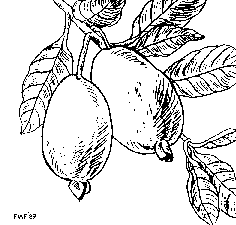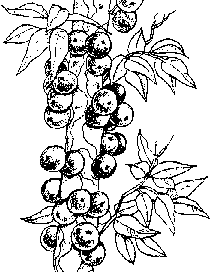FEIJOA

Feijoa sellowiana O.
Myrtaceae
Common Names: Feijoa, Pineapple Guava, Guavasteen.
Related Species: In more recent times Feijoa sellowiana has been renamed Acca sellowiana, but most sources still use the older name.
Distant affinity: Eugenias (Eugenia spp.), Guavas (Psidium spp.), Jaboticaba (Myrciaria spp.).
Origin: The feijoa is native to extreme southern Brazil, northern Argentina, western Paraguay and Uruguay where it is common in the mountains.
Adaptation: Feijoas prefer cool winters and moderate summers (80° to 90° F), and are generally adapted to areas where temperatures stay above 15° F. Flower production is poor in areas with fewer than 50 hours of chilling. The flavor of the fruit is much better in cool than in warm regions. Even thought the plants are relatively hardy, sudden fall frosts can damage ripening fruit and late spring frosts can destroy blossoms. Spring frost damage is most likely in mild-winter areas, where the plants are not completely hardened off and respond to warm spells by blooming early.
DESCRIPTION
Growth Habit: The feijoa is a slow-growing evergreen shrub that can reach 15 ft. high and 15 ft. wide. The bark is pale gray and the spreading branches are swollen at the nodes and white-hairy when young. In addition to the fruit it provides, the shrub also doubles handsomely as a landscape specimen. When planted close together, the shrubs make a nice hedge, screen, or windbreak. Feijoas can also be espaliered or trained as a small tree (20 to 25 ft. tall) with one or more trunks. The wood is dense, hard, and brittle.
Foliage: The evergreen, thick, leathery leaves of the feijoa are opposite, short-petioled and bluntly elliptical. In size they range from 1 to 2-1/2 inches long and 5/8 to 1 inch wide. The leaves are smooth soft green on top and silvery underneath, flashing nicely in a gentle breeze.
Flowers: The 1 inch showy, bisexual flowers, borne singly or in a cluster, have long, bright red stamens topped with large grains of yellow pollen. Flowers appear late, from May through June. Each flower contains four to six fleshy flower petals that are white tinged with purple on the inside. These petals are mildly sweet and edible and can make a refreshing addition to spring salads. Birds eating the petals pollinate the flower.
It has been said that feijoa pollen is transferred by birds that are attracted to and eat the flowers, but bees are the chief pollinators. Most flowers pollinated with compatible pollen show 60 to 90% fruit set. Hand pollination is nearly 100% effective. Two or more bushes should be planted together for cross-pollination unless the cultivar is known to be self-compatible. Poor bearing is usually the result of inadequate pollination.
Fruits: The fruits range from 3/4 to 3-1/2 inches long and vary in shape from round to elongated pear shape, with the persistent calyx segments adhering to the apex. The waxy skin is dull blue-green to blue or grayish green, sometimes with a red or orange blush. Skin texture varies from smooth to rough and pebbly and is 3/16 to 5/8 inch thick. The fruit emits a strong long-lasting perfume, even before it is fully ripe. The thick, white, granular, watery flesh and the translucent central pulp enclosing the seeds are sweet or subacid, suggesting a combination of pineapple and guava or pineapple and strawberry, often with overtones of winter green or spearmint. There are usually 20 – 40, occasionally more, very small, oblong seeds hardly noticeable when the fruit is eaten.
CULTURE
Location: To protect the fruit from sunburn and other adverse effects of high temperature, choose a plant site away from hot, reflected sun. The feijoa can tolerate partial shade and slight exposure to salt spray. They also make an excellent foundation planting, either singly or as an informal hedge.
Soil: Feijoas will grow in a wide variety of soils. The best harvests, however, come from plants growing in well-drained soil with a pH between 5.5 and 7.0. They are fairly salt tolerant, but salinity slows growth and reduces yields.
Irrigation: Foundation plantings of feijoas in summer dry California have survived for several years without supplemental water. Lack of water, however, will cause the fruit to drop. For quality harvests, water deeply on a regular basis, especially during flowering and fruit periods, and mulch the soil around the plants to protect the shallow roots.
Fertilization: Feijoas grow slowly and require only light applications of a complete fertilizer. A feeding of 8-8-8 NPK once every two months can speed growth.
Pruning: Pruning is not required to keep plants productive, but a light pruning in the summer after fruit is harvested will encourage new growth and increase yields the following year. Thinning the plant also permits easier harvesting. When grown as a hedge, the feijoa responds well to heavy pruning or shearing, but this reduces flower and fruit production.
Propagation: The feijoa grows easily from seed, but the seedlings are not always true to type. Seeds are separated by squeezing the seedy pulp into a container, covering with water, and letting the liquid stand for 4 days to ferment. The seeds are then strained out and dried before sowing. The seeds will retain viability for a year or more if kept dry. Germination takes place in 3 weeks. The plant fruits in 3 – 5 years from seed. Vegetative means are necessary to reproduce a variety. Young wood cuttings will root within two months with bottom heat and mist. Whip, tongue or veneer grafting methods are sometimes successful, as is air-layering and ground layering. Cutting-grown plants of named varieties are most desirable, because they can be trained in a variety of ways, and can be maintained as multitrunked shrubs without concern that suckers will develop into “rogue” branches.
Pests and diseases: The feijoa is remarkably pest and disease-resistant. It is occasionally attacked by by black scale in California, as well as fruit flies where that is a problem.
Harvest: In southern California the fruits ripen 4-1/2 to 6 months after flowers appear and in 5-1/2 to 7 months in the San Francisco area. As the fruit matures, its color changes almost imperceptibly. The best way is to allow them to fall from the tree. Giving the tree a shake and gathering the fruit from the ground every couple of days is the usual method of harvesting. To keep the fruit from bruising, place a tarp or other large cloth under the tree to catch them as they fall. Feijoas can also be picked when firm and mature and allowed to ripen at room temperature, although the quality will not be as good as tree ripened fruit. Mature fruit can be stored in the refrigerator for about a week, but after that the quality declines. Feijoas are mainly eaten fresh as a dessert or in salads, but can also be cooked in puddings, pies, etc. After peeling, the fruit should be immediately dipped into water containing fresh lemon juice to prevent the flesh from turning brown.
Commercial Potential: In California the feijoa is grown in a limited way for its fruit, especially in cool coastal locations, mainly around San Francisco. There has also been a major effort in New Zealand to commercialize the feijoa. Both domestic and imported fruit can often be found in the markets, but the demand does not seem to be great.
CULTIVARS
- Apollo
- Medium to large, oval fruit. Smooth, thin, light-green skin with blue-green surface bloom, subject to bruising and purpling. Pulp well-developed, slightly gritty. Flavor very pleasant, quality excellent. Ripens mid to late-season. Tree upright and spreading, to 8 ft. tall, vigorous and productive. Self-fertile, and will pollinate Gemini.
- Choiceana
- Originated in Australia. Small to medium-sized, round to oval fruit, 2 to 3-1/2 inches long. Skin fairly smooth. Flavor and quality good. Ripens in midseason. Tree moderately vigorous, spreading. Almost or always, but not less than 42% self-fertile.
- Coolidge
- Originated in Australia prior to 1908. Small to medium-sized fruit, 4 or more inches in length and 2-1/2 inches in diameter. Form pyriform to oblong or elongated. Skin somewhat wrinkled. Flavor mild, indifferent quality. Tree upright and strong growing, a reliable and heavy bearer, 100% self-fertile. The most widely planted cultivar in California.
- Edenvale Improved Coolidge
- Originated in Santa Cruz, Calif. by Frank Serpa of Edenvale Nurseries. Large, oblong fruit of very good to excellent flavor and quality. Ripens in October. Tree slow growing. Self-fertile, precocious and productive. Grows best in climates similar to cool, coastal ares of southern California.
- Edenvale Late
- From Edenvale Nurseries. Mediuim-sized, oblong fruit of very good to excellent flavor and quality. Ripens late, in January,and over a long period of time. Tree slow growing. Self-fertile, very productive. Grows best in climates similar to cool, coastal areas of southern California.
- Edenvale Supreme
- From Edenvale Nurseries. Medium-sized, oblong fruit of very good to excellent flavor and quality. Ripens in November. Best eaten soon after harvest. Tree slow growing. Self-fertile, precocious and productive. Grows best in climates similar to cool, coastal areas of southern California.
- Gemini
- Fruit small to medium, egg-shaped. Skin very smooth, thin, dark green with a heavy bloom. Flavor and texture excellent. Ripens in early autumn, earlier than Apollo. Tree upright, spreading, to 8 ft tall. Moderately vigorous, high yielding, partially self-fruitful, but cross pollination is recommended for best fruit quality.
- Mammoth
- Selected in New Zealand from seedlings of the Choiceana. Large, round to oval fruit, to 8-1/2 ounces, resembling Coolidge. Skin thick, somewhat wrinkled. Flesh somewhat gritty, quality and flavor very good. Matures early in midseason. Softer and not as good a shipper as Triumph. Tree of upright habit, to 10 ft. tall, strong growing. Self-fertile, but bears larger fruit, with cross-pollination.
- Moore
- Large, flavorsome fruit. Ripens in midseason. Very vigorous plant. Recommended for California.
- Nazemetz
- Originated in San Diego, Calif. by Alexander Nazemetz. Large, pear-shaped fruit, averaging 3 ounce in weight. Side walls moderately thin. Pulp translucent and sweet. Flavor and quality excellent. Ripens in late October to mid-December. Unlike that of many other cultivars, the pulp of Nazemetz does not darken after being cut or as it ripens, but retains its clear color. Tree self-fertile, but bears most heavily when cross-pollinated. Good pollinator for Trask.
- Pineapple Gem
- Originated in Azusa, Calif. by Monrovia Nursery. Small, round fruit of good to very good quality. Mid to late season ripening. Tree self-fruitful but bears heavier crops if pollinated. Does poorly under cool, coastal conditions.
- Trask
- Originated as a bud sport of Coolidge. Medium to large, oblong fruit, up to 3-1/2 inches long and weighing 3 to 5 ounces. Rough, dark green skin. Shells thicker and grittier than Coolidge. Flavor and quality good to very good. Ripens early. Tree self-fertile, but most productive when cross-pollinated. Precocious. Ideal pollinator for Nazemetz.
- Triumph
- Selected in New Zealand from seedlings of the Choiceana cultivar. Short, oval, plump fruits., not pointed as those of Coolidge, medium to large. Skin uneven but firm. Flesh somewhat gritty but with good seed to pulp ratio. Excellent sharp flavor. Ripens to midseason. Tree upright, of medium vigor. Bears heavily if pollinated. Good pollinator for Mammoth.
FURTHER READING
- Facciola, Stephen. Cornucopia: a Source Book of Edible Plants. Kampong Publications, 1990.
- Morton, Julia F. Fruits of Warm Climates. Creative Resources Systems, Inc. 1987. pp. 367-370.
- Ortho Books. All About Citrus and Subtropical Fruits. Chevron Chemical Co. 1985. pp. 44-45.
© Copyright 1996, California Rare Fruit Growers, Inc.
Questions or comments? Contact us.


